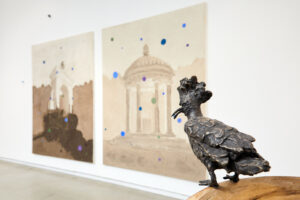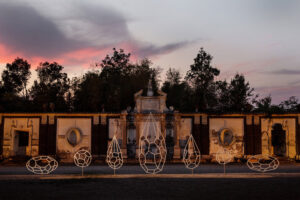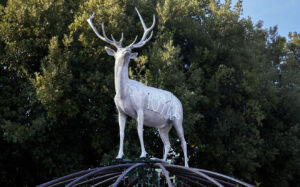Back to Nature, is a project conceived within the context of Romarama with the curatorial support of the art-historian and critic Costantino d’Orazio. It involves a series of Italian artists in a reflection on the relationship between man and nature, in response to the debate on climate change in the contemporary context. It is thought in relation to the museum complex and the park of Villa Borghese, always been one of the privileged places for local citizens and not only, and it establishes a dialogue between past, present and the surrounding landscape, through a series of in situ projects. As an elogy to nature, Back to Nature reflects the emergence of a new artistic sensibility towards the environment, making the most of the villa’s architectural, historical and museum heritage, through a series of isolated moments, and engaging the viewer in a promenade between the works of the artists and the trees of the park of Villa Borghese.
At the Carlo Bilotti Museum, orangery of Villa Borghese, Back to Nature presents the solo show Radici by sculptor Benedetto Pietromarchi, and curated by Paolo Falcone, an exhibition divided into three rooms, that aims at questioning the relationship between nature and artifice, biology and construction, in a renewed material and sensorial relationship with artistic making and practice. From a purely classic imprint of sculptural construction, Pietromarchi’s works present a visual ecology of the animal and natural world. Pietromarchi’s works, as the artist declares, were conceived in Pescia Fiorentina, where the artist lives, and are in dialogue with the history of the Villa Borghese Orangery. This is underlined by the sculpture 42 ° 26’21”N 11 ° 28 ‘13.9”E’, a large sculpture made with the root of a Maremma oak, and surmounted by a series of ceramic parrots, animals that once lived in the park of Villa Borghese, presented in the complex of a conceptual drawing of microspheres, as a metaphor for a process of pollination inside the museum. This is re-attested by the sculptures conceived as a tribute to the temple of Diana and the fountain of Aesculapius present in the Villa, where Pietromarchi takes up again the theme of the root to think of a vegetal and living sculpture, experimenting with the use of different materials such as lead and metal. This itinerary ends with a series of thirteen preparatory drawings in which animal and vegetable motifs are repeated and conceived in situ, flanked by a monumental terracotta bell which is a reinterpretation of the famous Borghese vase, in which, in addition to the motifs of the dragon and the eagle, emblem of the Borghese’s family, Pietromarchi introduces the coat of arms of the swan, a symbol of prosperity for the present.
At the Casa del Cinema and the Pietro Canonica Museum, artist Nico Vascellari presents the video Vitriol, 2020, a film-performance which reflects on the relationship between man, animal and nature away from any anthropocentric vision. Vascellari’s film suggests a new, immersive and pantheistic perspective on nature by focusing on the role of the artist as a medium who in the film, is suspended from a helicopter, and flies over vast landscapes of coniferous forests and woods, becoming the mediator of a cathartic experience between man and the environment.
Also at the Canonica Museum, the master Mimmo Paladino, presents Untitled (flags), 2020, a work consisting of a series of ten differently painted flags, where the artist takes up the coats of arms, details and decorations of the sculptures that historically adorned the avenues of Villa Borghese, which later became part of the archaeological collection of Cardinal Scipione Borghese and now part of the permanent collection of the Pietro Canonica museum. The result is a series of banners in which the portraits of divinities, emperors and nymphs merge in analogy with the morphology of the trees of the Villa Borghese Park, displayed on the battlements of the museum facade and otherwise, waved by the flag-waving group of the city of Cori, at the opening of the exhibition and the Giornata del Contemporaneo on the 12th October.
At the Loggia dei Vini, with the curatorship of Alessandra Mammi, artist Grazia Toderi presents Red Map, 2020, an installation consisting of five moving ellipses drawing a celestial and terrestrial map, an immersive complex whereby we are allowed to rethink universal and human laws, through a cosmic and at the same time rooted perspective, pursuing the humanistic idea that man is a reflection of the cosmos and the universe.
At the Parco dei Daini, a series of environmental interventions follow one another in dialogue with the surrounding landscape. In the spaces of the Meridiana, the work Bufala, 2019, by Davide Rivalta, looks at the man-animal relationship, in a comparison between traditional and experimental practices and techniques. Edoardo Tresoldi, presents Etherea, 2018, a transparent sculpture inspired by Baroque architecture and in dialogue with the surrounding trees. If Accademia Aracne presents Yarn bombing, 2020, observing the transformation process of the trees, Wing Project offers a playful and interactive experience with the viewer, presenting a series of panels painted as wings, simulating an angelic flight over the landscape. In dialogue with the Secret Gardens of the Borghese Gallery, the artist Andreco presents Drops, 2020, a series of seven sculptures conceived from the study of geometric shapes, like drops to distill reflections on the future of a new relationship between man and environment. The itinerary concludes with the work of Mario Merz, Untitled, (Igloo di Oporto), 1998, an igloo on top of which a deer stands with a watchful eye, and in which a progressive numerical series is repeated, taken from the formulas of the mathematician of the XIII century, Leonardo Fibonacci, system designed to explain the rules of the growth and evolution of natural elements. A reflection on the art of making, relationships and contexts, a new humanism that takes into account the geometric and mathematical laws, are the hallmarks of the works of the artists present at Back to Nature, wherein the equilibrium between man and the environment seems once again poetically possible, as well as sustainable.
Info:
 Backtonature, Benedetto Pietromarchi al Museo Bilotti @Simon d’Exéa
Backtonature, Benedetto Pietromarchi al Museo Bilotti @Simon d’Exéa
 Andreco, Studio Drops State of Matter, ph. Giorgio Coen Cagli
Andreco, Studio Drops State of Matter, ph. Giorgio Coen Cagli
 Mario Merz, Senza titolo (Igloo di Oporto), 1998 @Simon d’Exéa
Mario Merz, Senza titolo (Igloo di Oporto), 1998 @Simon d’Exéa
 Davide Rivalta, Bufala, 2020 @Simon d’Exéa
Davide Rivalta, Bufala, 2020 @Simon d’Exéa
 Edoardo Tresoldi, Etherea, 2018, ph. Roberto Conte
Edoardo Tresoldi, Etherea, 2018, ph. Roberto Conte

She is interested in the visual, verbal and textual aspects of the Modern Contemporary Arts. From historical-artistic studies at the Cà Foscari University, Venice, she has specialized in teaching and curatorial practice at the IED, Rome, and Christie’s London. The field of her research activity focuses on the theme of Light from the 1950s to current times, ontologically considering artistic, phenomenological and visual innovation aspects.






NO COMMENT